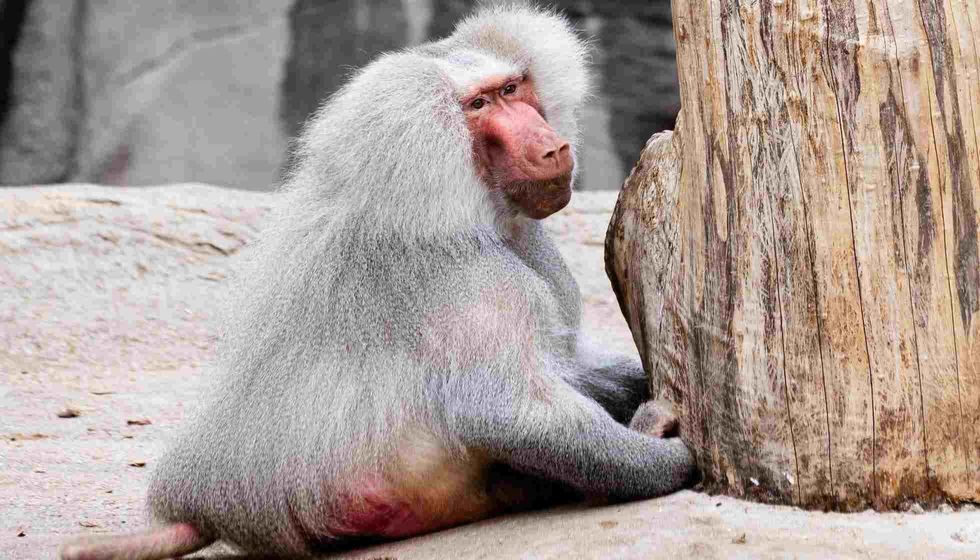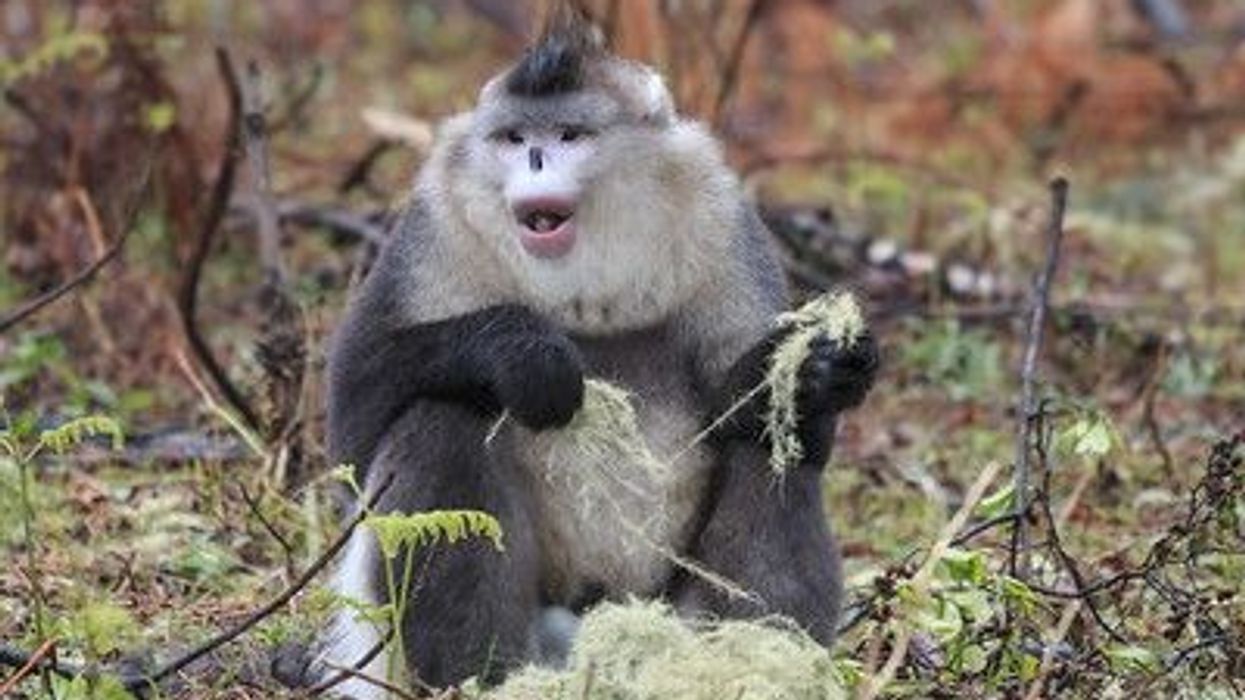Baboons have existed for at least 2 million years. There are five types of baboons: the hamadryas baboon, Guinea baboon, olive baboon, yellow baboon, and chacma baboon.
Baboons are smart and social creatures and depending upon their species, they vary in size and weight. Among these five baboon species, the chacma baboon is the largest and is also considered the most dangerous. The hamadryas baboon (Papio hamadryas) was considered a sacred baboon in ancient Egypt.
Today these baboons can be found in the African and Asian continents, namely in Eritrea, Djibouti, Ethiopia, Somalia, Saudi Arabia, and Yemen. Hamadryas baboons are strongly built monkeys with brown or light gray fur.
The male baboons have a distinctive mantle of long silvery hair and a bright pink face, while the females have hairless black and grayish brown faces. Both male and female hamadryas baboons have a red-colored rump and long tufted tails. These hamadryas baboons live in hillsides of semidesert areas, savannas, and arid habitats.
Hamadryas Baboon Interesting Facts
What type of animal is a hamadryas baboon?
Hamadryas baboons are a well-built, sturdy baboon species from the Cercopithecidae family.
What class of animal does a hamadryas baboon belong to?
A hamadryas baboon belongs to the Mammalia class (just like pandas do!), and it is in the Cercopithecidae family of small terrestrial mammals.
How many hamadryas baboons are there in the world?
It is not known exactly how many hamadryas baboons there are in the world. Hamadryas baboons can be found in Africa as well as in Asia. The climate differences between their different homes have led to different physical appearances, as well as behavioral, and genetic differences.
Where does a hamadryas baboon live?
Hamadryas baboons today are found mainly in East African countries like Eritrea, Djibouti, Ethiopia, Somalia, and some parts of North Africa like Sudan. These baboons can also be found in the Sarawat mountains of the Western Arabian Peninsula and Middle Eastern countries like Saudi Arabia and Yemen.
What is a hamadryas baboon's habitat?
The native habitats of hamadryas baboons include many grasslands, rocky areas, semidesert areas, and arid bushlands. These Old World monkeys also generally live near high cliffs to gain easy access to food and water. A safe habitat is important for the hamadryas baboon (Papio hamadryas) as they are at risk from predators including cheetahs, leopards, hyenas, and eagles.
Who do hamadryas baboons live with?
Hamadryas baboons usually live in large groups on cliffs in the wild. So they live together with other hamadryas baboons. According to Ancient Egyptian ideas, they can be trained and socialized to replicate human behavior.
How long does a hamadryas baboon live?
The hamadryas baboon (Papio hamadryas) has a maximum lifespan of 37 years when receiving expert care. However, this is slightly less for hamadryas baboons living in the wild.
How do they reproduce?
Males and female Papio hamadryas reach maturity sometime between four and six years of age. An adult male Papio hamadryas forms a one-male unit once it reaches adulthood.
To reproduce, the dominant male hamadryas baboon mates with a female from his unit. Females give birth to one baby at a time with a gestation period of 180 days. The dominant male takes on the responsibility for social grooming and protects their kin.
What is their conservation status?
The International Union for Conservation of Nature (ICUN), a global environmental union founded to protect and conserve nature, found that hamadryas baboons were a rare species during their assessments between 1988 to 1990.
Later, due to an increase in population from 1996, its status became a lower risk, and by the 2016 assessment, it was listed as a species of Least Concern.
Despite this, issues of habitat loss are still a concern for the species.
Hamadryas Baboon Fun Facts
What do hamadryas baboons look like?
Hamadryas baboons have dog-like muzzles, strong jaws with sharp teeth, close-set eyes, thick fur, and a short tail. The adult male has a silver-white color cape, a naked pink face, and a rump, and females are cape-less with black and brown faces.
How cute are they?
These baboons and interesting and cute animals. Although not cute and cuddly, they are adorable in another way, particularly due to their social grooming! Have you ever been lucky enough to see a hamadryas baboon at a zoo?
How do they communicate?
To communicate among themselves, both males and females use vocal signals, visual signals, and gestures.
How big is a hamadryas baboon?
A male is on average 32 in (82 cm) tall, and a female will be between 20–26 in (50–65 cm) tall from head to bottom. The tail adds a further 12–24 in (31–61 cm) to their length and ends in a small tuft.
Males are almost twice the size of females and the hamadryas baboon is normally much larger in size than a monkey.
How fast can a hamadryas baboon run?
Like any other baboon species, the hamadryas baboon (Papio hamadryas) can run at a speed of up to 30 mph (48 kph) and in the wild can be expected to cover up to 4 m (6.4 km) daily.
How much does a hamadryas baboon weigh?
An average adult male weighs 44–66 lb (20–30 kg) and females weigh about 22–33 lb (10–15 kg). A male hamadryas baboon typically weighs double the weight of a female.
What are their male and female names of the species?
Hamadryas baboons are simply referred to as male hamadryas baboons and female hamadryas baboons based on their gender. However, this breed does have an interesting and unique social structure.
The dominant male of one male unit is referred to as the 'leader' or 'harem male' and another young male in the unit is called a 'follower'.
Females who are more socially active in the unit and are more closely bonded with the harem male are known as 'central females'. Females who spend the majority of their time outside the unit are called 'peripheral females'.
What would you call a baby hamadryas baboon?
A baby hamadryas baboon is usually referred to as 'kin'. The leader or harem male of the One Male Unit shares special bonds with their kin.
What do they eat?
Hamadryas baboons are omnivorous and they can survive on low-quality diets for long periods of time. In the wet season, they primarily eat grasses, seeds, fruits, berries, roots, flowers, leaves, and pods of acacia trees.
They eat Dobera glabra shrubs and sisal leaves during the dry seasons. These baboons also prey on insects, worms, reptiles, birds, locusts, small mammals, including antelopes sometimes.
Are they loud?
As another primitive family, this species can be very loud, making different sounds including grunts, barks, yaks, and 'wahoos'. Females make copulation calls, whereas adult males make long-distance contact calls.
Would they make a good pet?
These animals prefer to live in their social groups called troops and would not be suitable pets. If you want to see one out of the wild, you can try a visit to your local zoo!
Did you know...
Hamadryas baboons in ancient Egypt were considered to be linked to Thoth, the god of learning. In ancient Egyptian religion, they are termed 'babi' or 'baba', which means 'bull of the baboons' or 'chief of the baboons'.
Therefore, many ancient Egyptian sculptures and paintings exhibit humans worshiping baboons in the sun with raised hands. Some Egyptian gods were also portrayed with baboon heads in some works of art.
The hamadryas baboon's social dynamics
Hamadryas baboons are highly intelligent animals. Their society is usually male dominant as these baboons form social units called One Male Units or harems consisting of one male leader and up to ten female baboons. The male leader guards females and their offspring.
Sometimes there are two males in the unit to monopolize more food resources. A group of one-male units can come together to form clans.
If these clans gather together they form groups called bands. Finally, several bands make a troop. Large troops of several hundred baboons can form a close bond as they live together and search for food.
Are hamadryas baboons endangered?
With their existence becoming more stable among growing populations, the International Union for Conservation of Nature listed the hamadryas baboons as a species of Least Concern in 2008.
Here at Kidadl, we have carefully created many interesting family-friendly animal facts for everyone to discover!
You can even occupy yourself at home by drawing one on our sock monkey coloring pages.









